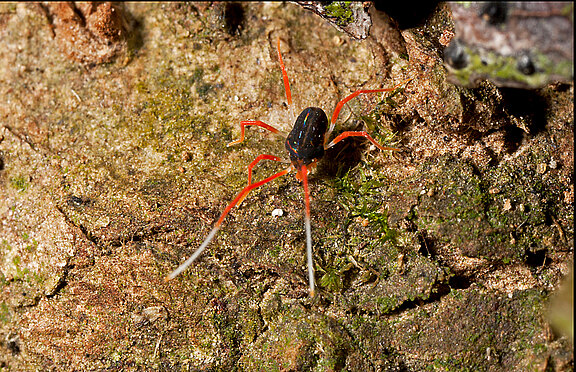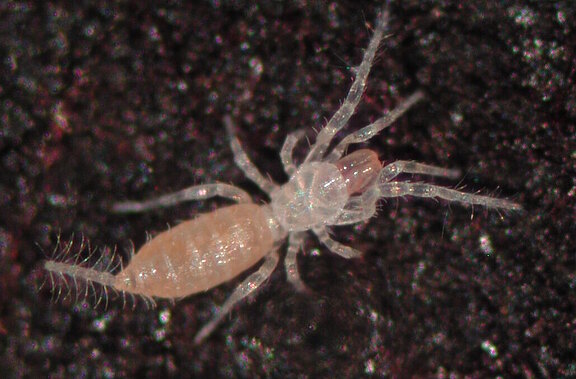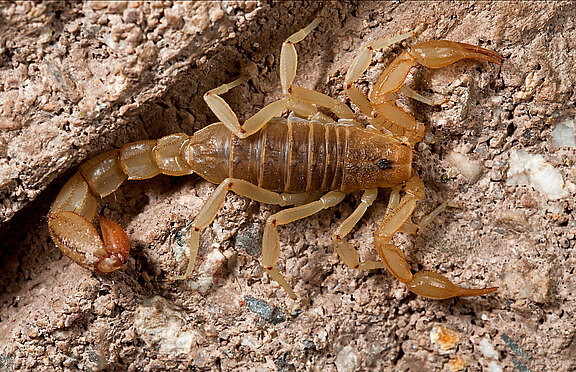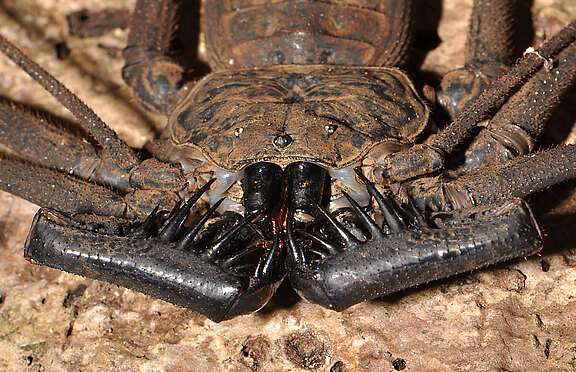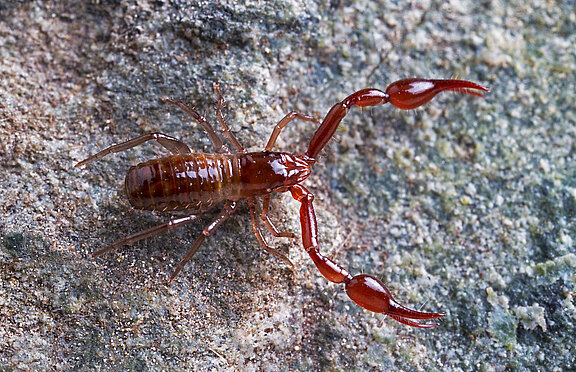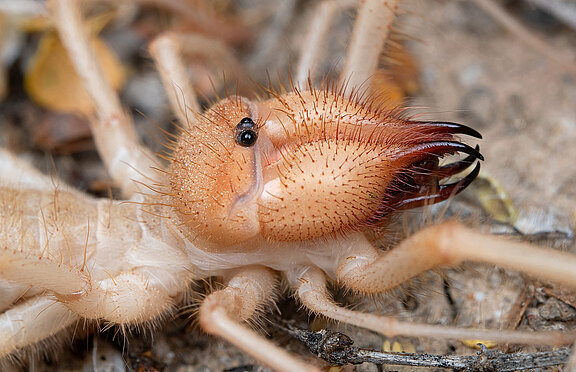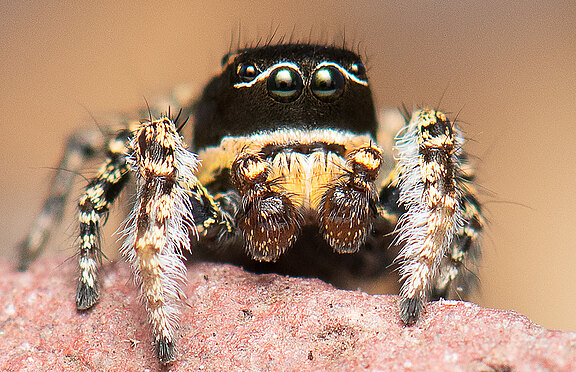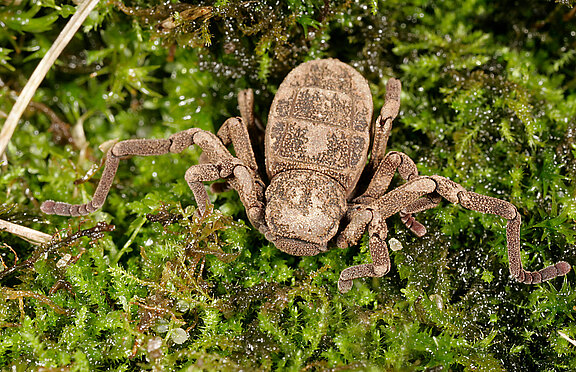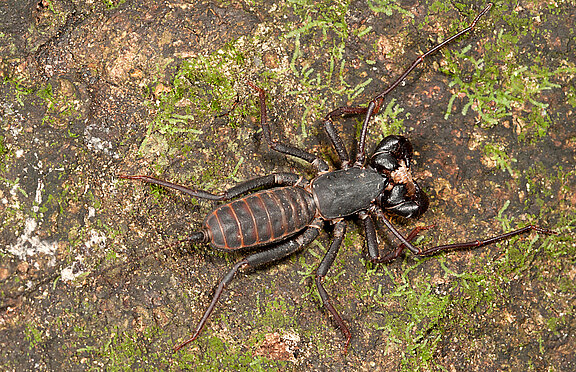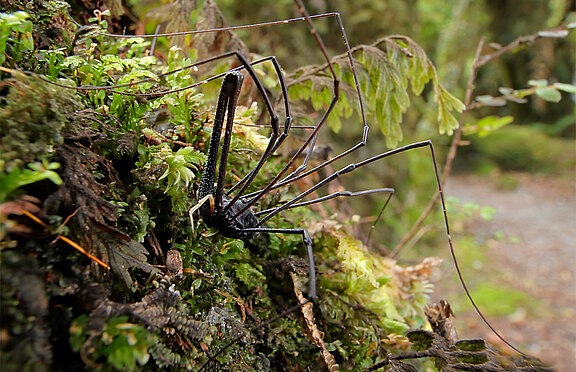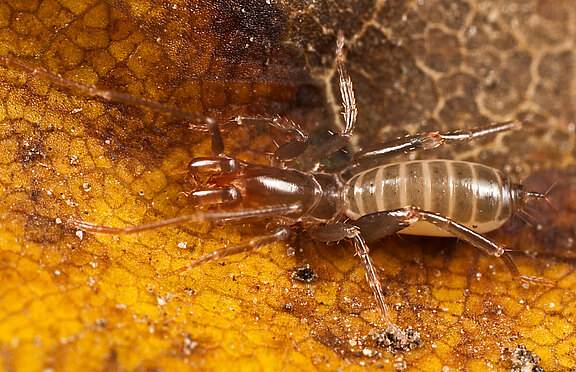List of all articles
Volume 53 Number 2
gut analysis, monoclonal antibody, grape, omnivorous leafroller, biological control
Abstract
We developed a monoclonal antibody (MAb) to Platynota stultana (Tortricidae, common name omnivorous leafroller), a key pest of grape in California, and used it to detect predation by spiders in San Joaquin Valley vineyards. Using an enzyme-lined immunosorbant assay, we found a MAb with high specificity to P. stultana, with no cross reaction to several non-lepidopteran insects, and minor reaction to other lepidopteran species. We tested the MAb on four spiders: Cheiracanthium inclusum (Hentz, 1847) (Cheiracanthiidae), Trachelas pacificus Chamberlin & Ivie, 1935 (Trachelidae), Oxyopes spp. (Oxyopidae) and Hololena nedra Chamberlin & Ivie, 1942 (Agelenidae), and found for all but C. inclusum, there was reactivity to spiders which had eaten P. stultana larvae in the laboratory. We sampled spiders from two Fresno County vineyards, assaying by species and weight at antigen dilutions of 1:100 and 1:1000. None of the small-sized Oxyopes spp. or H. nedra specimens was positive, but 8.8% of the medium-sized Oxyopes spp. and 33.3% of the medium- and large-sized H. nedra specimens were. 28.5% of the small-, 57.1% of the medium- and 66.6% of the large-sized T. pacificus specimens tested positive. Our interpretation is that the H. nedra positives resulted from P. stultana moth capture, and that Oxyopes spp. prey upon P. stultana larvae, but have a limited ability to capture them. Trachelas pacificus appears to be an effective predator of immature P. stultana, capable of finding and consuming those hidden in their nests, and may play a positive role in lowering its population density.
Volume 53 Number 2
harvestmen, Neotropics, caves, troglomorphism, troglobites
Abstract
A new troglobitic species belonging to the genus Paratricommatus Piza, 1943 (Cryptogeobiidae), was found in a cave in the Pains municipality, Minas Gerais state, Brazil, and is described here. Paratricommatus infernalis sp. nov. is distinguished from all other species in the genus by having the IV femur 1.5–2.5 longer than the dorsal shield (instead of the IV femur shorter than the dorsal shield) and small eyes with reduced pigmentation. This new species presents several troglomorphic traits, such as elongated legs and different degrees of reduction in integumentary and ocular pigmentation, in addition to being absent in epigean environments. Thus, it is considered a troglobitic species and may represent a relic, as evidenced by its geographic isolation from other Cryptogeobiidae species.
Volume 53 Number 2
Araneae, courtship, Deinopidae, sexual behavior, sperm web
Abstract
In the present study, the reproductive behavior of a representative of the Deinopidae family, Deinopis cf. cylindracea C. L. Koch, 1846, is described for the first time. The behavioral aspects observed were the construction of the male's sperm web, male's approach to fertilization, and end of the couple's pairing. As soon as a male found a female, he began sperm induction. The sperm web is a Y-shaped web, whose internal space forms a flat surface onto which the male deposits his gametes. Sperm were then collected by his copulatory bulbs from the opposite side of the web. After transferring the sperm drops to the pedipalp, the male walked towards the female, approaching her from the dorsal-abdominal region using the dragline thread of the web. The male used his legs to touch both the web and female spider, inducing the female to let go, and positioned her ventral region towards his cephalothorax. The couple hung upside down; the female was suspended by a thread, her cephalothorax perpendicular to the floor. In this position, the male inserted the embolus of the copulatory bulb into the female epigynum and transferred the sperm. The male separated quickly by extending his legs and moving away, returning to an uppermost position in relation to the female. The female, in turn, returned to the prey-ready posture, clipping the capture net again and positioning herself in the same manner as before the reproductive behavior.
Volume 53 Number 2
cytochrome c oxidase I, Endemism, metabarcoding, sky islands
Abstract
The intraspecific diversity of the few mygalomorph spiders in southern Appalachia has received considerable attention, revealing highly localized and deeply divergent populations and in some cases cryptic species. The araneomorph fauna of the region has received comparatively little study, due to its higher diversity, more tentative taxonomy, and perhaps perception that short-range endemicity might be lower. In this study, we examined this last assumption, surveying patterns of intraspecific diversity across Araneomorphae occurring in the leaf litter of high elevation spruce-fir sky islands of southern Appalachia, as revealed by population level metabarcoding. In most species, intraspecific haplotypic diversity, while high, revealed little geographic pattern, generally supporting assumptions of low regional endemicity. Of 50 spider species found in spruce-fir forest litter, more than 30 occur more widely, and showed little sign of subdivision even over major biogeographic features in the region, such as the French Broad River valley. By analyzing 10 of these well-sampled species with population genetic and phylogeographic methods, we found that only a few showed significant population level subdivisions. We suggest that the ballooning behavior of most immature araneomorph spiders is sufficiently frequent to overcome divergence of otherwise isolated populations, and that in those few exceptions the species are more specialized to particular microhabitats in the spruce-fir forest and such unpredictable dispersal may have been selected against.
Volume 53 Number 2
Mygalomorphs, RNA quality, spiders, tissue RNA isolation, aranhas, Caranguejeiras, Isolamento de RNA tecidual, Qualidade de RNA
Abstract
Systemic optimization of RNA extraction protocols in non-model arachnids is indispensable for gene expression studies, including transcriptome sequencing and analyses. Spinnerets of the Neotropical tarantula Grammostola actaeon (Pocock, 1903) (family Theraphosidae) were used to evaluate the performance of two RNA extraction reagents and three commercially available kits for isolating total RNA from small eukaryotic tissue samples. Total RNA was extracted from spinneret tissues, using two samples for each method. We used the commercially available reagents TRIzol and NucleoZOL and the RNA extraction kits NucleoSpin and NucleoSpin XS (Macherey Nagel) and Total RNA Purification Kit (Norgen Biotek Corp). Quantification using Qubit revealed that NucleoSpin, Norgen, and NucleoSpin XS resulted in the highest RNA yields respectively, while Nanodrop analysis ranked Norgen, TRIzol, NucleoSpin, NucleoSpin XS in descending order. Bioanalyzer analysis indicated that Nucleospin, and NucleoSpin XS delivered the best results for our samples. While each method successfully yielded sufficient RNA for RNA-seq experiments, variations in RNA quality among methods indicate differences in their suitability for specific applications. Our data provide further evidence that RNA integrity number (RIN)-based assessments in G. actaeon may not be reliable for evaluating RNA quality due to a widespread occurrence of the ‘gap deletion’ phenomenon in arthropods. RNA from species with 28S rRNA collapsed can yield high-quality transcriptomes, suggesting that current RIN-based assessments may not be reliable for evaluating RNA quality in many non-model invertebrates. Overall, differences in results of commercially available RNA extraction reagents/kits should be considered when selecting the most appropriate RNA extraction method for gene expression analysis.
Volume 53 Number 2
spider silk, silk spinning-behavior, silk types, multi-method approach
Abstract
Spiders possess multiple types of silk glands, producing silk materials with contrasting properties, which are deployed in distinct behavioral contexts, such as locomotion, prey capture and egg casing. Whereas the diversity of silk glands and spigots across different spider families is relatively well described, their biological functions (i.e., with which behavior each gland type is activated) are poorly known. Here we provide an overview about available methods and approaches to determine the biological function of spider silk glands, and evaluate their advantages and disadvantages based on our experiences and a test study on Pholcus phalangioides (Fuesslin, 1775) (Pholcidae) and Kukulcania hibernalis (Hentz, 1842) (Filistatidae).
Volume 53 Number 2
Argiope trifasciata, Aggregate glue, silk gland-specific expression
Abstract
Orb web weaving spiders, like Argiope trifasciata (Forsskål, 1775), rely on sticky aggregate glue droplets on the capture spiral of their web to retain prey. Here, we compared the protein composition of the glue droplets placed at the bottom of the web early in capture spiral construction, to those placed at the inside of the web late in web construction. We found a lower abundance of aggregate proteins in the inner web, where the droplets are smaller, are less extensible, and contain a higher proportion of water. Interestingly, we also found that pyriform spidroin, which anchors bridging lines of the web to the substrate, was more abundant in the inner region of the web, which has a higher density of capture spiral-radial line junctions. We propose that pyriform spidroin has a previously unidentified role in orb webs: anchoring the capture spiral to radial lines.
Volume 53 Number 2
Bee tag, movement range, phenology, spider conservation, wolf spider
Abstract
Among the variety of wolf spiders in Europe, there are some uncommon and poorly known species. An example is Pardosa paludicola (Clerck, 1757), which is classified as endangered and rare in some countries. We used a capture-mark-recapture method to examine the biology of mature P. paludicola individuals, focusing on the movement ranges of this spider. We marked 714 individuals and more than 10% of them were recaptured (♂ 4.5% and ♀ 14.7%). The median movement range was calculated at 5–6 m for both sexes and the maximum distances reached 58–69 m in 3–4 days. In the context of conservation efforts for this species, it seems important to provide large open areas of high humidity, with low human interference.
Volume 53 Number 2
Anurophagy, bird nestlings, Florida, Phidippus regius, predation, predation attempts, Saurophagy
Abstract
In this study, we provide an update on the knowledge of vertebrate-eating jumping spiders. Twenty-four reports of jumping spider predation on vertebrates are known, which are attributed to seven species: Hyllus diardi (Walckenaer, 1837), H. semicupreus (Simon, 1885), H. treleaveni GW Peckham & EG Peckham, 1902, Paraphidippus cf. aurantius, Phidippus bidentatus FO Pickard-Cambridge, 1901, P. regius CL Koch, 1846, and an unknown species apparently related to Hasarius Simon, 1871. In addition, several unsuccessful predation attempts by Phidippus audax (Hentz, 1845) on hummingbird and chickadee nestlings are documented. Furthermore, an incident of Phidippus otiosus (Hentz, 1846) feeding on an oversized gecko carcass (likely a case of scavenging) is reported. Overall, incidents of vertebrate predation by salticids are likely to be, in most cases, very rare chance encounters between a tiny vertebrate and a hungry spider. In contrast, the case of Phidippus regius is unique for salticids as—to the current state of knowledge—this is the only salticid species in which vertebrate consumption has been reported numerous times (n = 18) and in many different locations (11 different Florida counties, USA).
Volume 53 Number 1
visual signals, vibratory/seismic signals, power spectrum, stridulation, percussion
Abstract
Wolf spiders (Araneae: Lycosidae) in the genus Schizocosa Chamberlin, 1904 show a diverse array of male courtship behaviors, signaling modes and morphological traits, and have been the subject of extensive study. Although S. saltatrix (Hentz, 1844) is not as well-studied as some of its congeners, this species occupies a phylogenetic position basal to the well-studied ocreata clade within the genus. Here, we present a detailed analyses of its courtship and provide some insights about multimodal signals in the genus Schizocosa. Male and female S. saltatrix were collected from the field and raised to maturity in the lab, then paired randomly for mating trials, in which courtship and mating behaviors were recorded. Male courtship displays consist of vibratory signals coupled with leg-raising visual signals, suggesting that males apparently use complex (multimodal) signals in courtship despite assumptions from other studies. While the overall amplitude of vibratory signals is not related to mating success, rates and amplitude of some individual components (leg strikes) appear to play a role. Female responses show that variation in visual and vibratory signals is associated with receptivity and mating success, although signal information content (e.g., body condition) is unclear. Although visual displays may serve as attention-altering signals and attract female attention, vibratory signals are more important to receptivity. Recent phylogenies suggest that while leg decorations, extensive leg pigmentation and visual signals have likely been secondarily lost, visual displays are retained in S. saltatrix, perhaps as attention-altering signals.
Volume 53 Number 1
protogyny, sperm competition, spermathecae
Abstract
The reproductive phenology of a species of phalangiid harvestmen, Odiellus aspersus, was studied at Maruyama Park, Sapporo, Hokkaido, for the difference in adult emergence between males and females. At the timepoint in which 50% of the population had matured to adulthood, more females were represented than males, and adult females developed about 10 days earlier on average than males. There was no difference in adult body size between males that had matured earlier and males that were collected later in the season. This fact would conflict with a plausible hypothesis that males should mature slowly to attain larger body size in this species. Elongation of spermatheca in females of the species may explain the marked difference in the adult emergence in the species, by enhancing sperm priority of the males that copulated with females last.
Volume 53 Number 1
sperm competition, life history, ovarian development
Abstract
The reproductive phenology of Himalphalangium spinulatum (Roewer, 1911) (Eupnoi: Phalangiidae), which overwinter as juveniles and mature in early summer, was surveyed at a riparian forest on the Sendai River, Tottori City, Honshu, Japan. Females became adults about 3–4 days earlier than males. The body weight of females and males and the number of mature eggs retained in females were highest at the age about a week after the final molting, suggesting a shorter time is needed to commence mating and oviposition in this species. This might be the reason for the shorter time lag in maturation between females and males in this species compared to other species of protogynous harvestmen.
Volume 53 Number 1
Deinopid, cribellate silk, silk glands, spigot, spinneret
Abstract
Net-casting spiders (Deinopidae) are cribellate spiders that spin a rectangular, sticky net that is held stretched between the claws of their first two pairs of legs. Deinopids produce eight distinct silk types, but knowledge of the silk-producing morphologies is mostly limited to the spigots associated with different fibers. As there have been no studies of deinopid silk gland structure, we dissected all the silk glands from Deinopis spinosa Marx, 1889 and document their number and morphology. We found silk gland position and morphology consistent with the type and number of silk spigots described for Deinopidae. Notably, for the first time, we describe the silk glands associated with cribellate silk: paracribellate, pseudoflagelliform, and cribellar silk glands. Our findings support the homology of pseudoflagelliform glands with araneoid flagelliform glands and will have importance for informing our understanding of spider web evolution.
Volume 53 Number 1
2025 Vol. 53-1 Pages: 26-29
learning, negative stimulus, shock platform, cognition
Abstract
Aversive conditioning is a form of associative learning. Here, we investigated learning and memory capacity of the harvester Mischonyx squalidus (Roewer, 1913), to examine the formation of short (STM) and long-term memories (LTM). First, we trained harvesters to associate an aversive stimulus (shock) with a neutral stimulus (tea odor). Each subject went through three consecutive trials, in which pairings between the stimuli lasted for 3s, with intervals of 1 (STM) and 30 (LTM) min. Subsequently, to test memory, we introduced the subjects in a choice arena where they could choose between staying in either of two areas: impregnated with tea chemicals or blank. We did this immediately after the conditioning phase or 24h after it. Both protocols were successful for STM within the same-day test, but not for LTM on the following day. In summary, we provide a new method to train aversive conditioning in harvesters and evidence for short-term memory.
Volume 53 Number 1
2025 Vol. 53-1 Pages: 30-53
morphology, genetic distances, cytochrome c oxidase subunit 1 (CO1), morphological variation, northeastern Mexico
Abstract
Mexico boasts the highest number of known ricinuleid species worldwide, however the diversity from North America is still poorly known. Herein, we evaluate Pseudocellus pelaezi (Coronado-Gutiérrez, 1970), a dimorphic species distributed in San Luis Potosí and Tamaulipas, northeastern Mexico. This species represents the first known dimorphic species of ricinuleids, well-documented based on morphology, ultrastructure, and genetic distance. The average intraspecific genetic distance (p-distance) at the mitochondrial cytochrome c oxidase subunit 1 (CO1) within P. pelaezi was 4.1%, whereas a much higher value of 14.6% was found between analyzed species of Pseudocellus Platnick, 1980. Although the genetic distance within the species is .4%, the morphology of primary sexual structures such as the male copulatory apparatus of leg III and the female spermathecae were strongly conserved across all the specimens. However, the morphology of a secondary sexual structure, male femora II, showed variation, with some males possessing a thin femora II (morpho 1-M1) (homeomorphic) and others with a wide femora II (morpho 2-M2) (heteromorphic). This male dimorphism, even within the same population of P. pelaezi, might be considered as a direct effect of sexual competition among males to mate with females, however more studies are needed to test this in ricinuleids. This could be done by studying and evaluating the sexual behavior in combination with the genetic evidence from specimens across several populations, offering insight into whether such dimorphism and/or genetic variation is correlated with sexual competition or represents underestimated diversity yet to be described.
Volume 53 Number 1
Opiliones, omnivory, feeding history, SEM
Abstract
Harvestmen are generally considered to be omnivores. In contrast to most other arachnids that are fluid feeders, harvestmen are capable of ingesting solid food particles and may consume invertebrates, small vertebrates, plant tissues, fungi, and detritus. However, for most species, quantitative diet data are lacking. Stable nitrogen isotope analysis provides a means to measure the contribution of these materials to the diet over the time scale of tissue turnover, and thus quantify trophic position. Examination of fecal material can provide additional evidence of recent feeding, which can further complement field observations and isotopic analyses. We investigated the diet of Erginulus clavotibialis (F.O. Pickard-Cambridge, 1905) (Arachnida, Opiliones, Cosmetidae) in western Belize, using stable isotope analysis and scanning electron microscopy of fecal samples. We also examined nitrogen isotopic ratios for carnivores (scorpions and spiders), herbivores (grasshoppers and katydids), and preliminary measures for two other harvestmen species, ants, and termites. Erginulus clavotibialis had δ15N signatures similar to scorpions and spiders, indicating carnivory. Nymphs and adults (females and males) of E. clavotibialis did not differ significantly in their trophic level despite possessing chelicerae and pedipalps that differ substantially in relative size and morphology. Fecal samples contained considerable evidence of arthropod consumption, as fragments of legs and exoskeleton were evident. Our study provides an initial quantification of harvestman diet and documents that E. clavotibialis is primarily carnivorous.
Volume 53 Number 1
2025 Vol. 53-1 Pages: 62-76
orb web construction, radius tensions, sticky spiral spacing
Abstract
Sticky spiral construction behavior in orb-weaving spiders is strikingly flexible: 10 to 16 different cues influence the hundreds of decisions that a spider makes while building the sticky spiral in an orb. Several variables that are influenced by radial tensions, including the frequencies and amplitudes of vibrations and the extensibility and tensions of the radii, have been repeatedly mentioned as possible cues guiding sticky spiral placement. Nevertheless, previous studies have suggested that radius tensions do not affect sticky spiral spacing. These tests were complicated, however, by the tight correlations between variables due to the highly regular geometry of orbs, possible context-dependent variation in the use of cues, and the intrinsic difficulty of demonstrating the absence of an effect. Greater certainty regarding tension-dependent cues is crucial for understanding the cues guiding orb construction, so this study extends these experiments, examining the effects of both increasing and decreasing radius tension, and of different sequences and magnitudes of changes. The results confirm previous findings: changes in radius tensions did not influence sticky spiral spacing decisions in consistent ways and generally failed to produce statistically significant effects. I argue that the likely reason why spiders do not use tension-dependent variables to guide sticky spiral placement is that such cues are unreliable because the spider's own weight substantially alters the tensions on nearby web lines in complex and variable ways.
Volume 53 Number 1
Arachnida, biospeleology, Caatinga, Neotropics, zoogeography
Abstract
During a study of the pseudoscorpion fauna of caves in northeastern Brazil, a new species of the genus Neoallochernes Hoff, 1947 was discovered. Morphological analysis suggests that the new species, named Neoallochernes catimbauensis sp. nov., is closely related to N. cubanus Muchmore, 1992. Neoallochernes catimbauensis can be distinguished from other congeners by its spermathecae morphology, trichobothria ib and ist positioned subbasally, trichobothrium isb located subdistally to the middle of the finger and proximal to est. Femur length/width ratios were 2.83× (♀) and 2.42–2.62× (♂); patella width ratios were 2.34× (♀) and 2.29–2.31× (♂); and chela (without pedicel) ratios were 3.34× (♀) and 3.18–3.21× (♂). In addition, ecological observations, distribution maps including past and present records, and a taxonomic identification key are provided.
Volume 52 Number 3
Cannibalism, ontogenetic diet shift, predator-prey size relationship, prey composition
Abstract
Scorpions are diverse and abundant in tropical and subtropical regions worldwide, especially in arid ecosystems where they play a relevant role as predators. However, few studies have examined diet composition, use of alternative foraging strategies, prey selection, and predator-prey size relationships of scorpions in different microhabitats. This study provides an analysis of the diet of Buthus montanus Lourenço & Vachon, 2004 in an arid area of SE Spain. Prey captured by scorpions were recorded during black-light censuses over the main activity season of B. montanus in the study area. Because scorpions were observed capturing prey on the ground surface, below ground, and in vegetation, prey availability was estimated using complementary methods for shrub- and ground-dwelling prey. Results show that B. montanus is a generalist predator that feeds on a diverse array of prey, although predatory arthropods and tenebrionid larvae comprised the highest proportion of its diet in both number of prey and biomass. Cannibalism was a major component of its diet, accounting for almost 25% of the biomass ingested, especially in large scorpions. The composition of the diet, prey-size variability, and predator-prey size relationship showed size-related differences. These size-related variations in the diet were also linked to habitat use, due to climbing vegetation by smaller scorpions. These results highlight the implications of ontogenetic shifts in the diet of B. montanus related to cannibalism by larger scorpions and climbing vegetation by smaller individuals, causing changes in the type of prey used by individuals of different size and predator-prey size relationships.
Volume 52 Number 3
Development, mating, predation, diet, parasitoid
Abstract
Australia is home to an incredible diversity of spiders, but much of their biology remains unstudied. The orb-weaving spiders (family Araneidae) are especially diverse and frequently encountered, yet the ecology of very few species has been explored. The common name “Australian garden orb-weaver” refers to several species, including Hortophora transmarina (Keyserling, 1865), found mostly along Australia's east coast, and Hortophora biapicata (L Koch, 1871), found mostly along Australia's south and south-eastern coasts. These two similar species are large, nocturnal orb-weavers that occupy a wide range of both natural and anthropogenically disturbed habitats. Here, I describe the general morphology, habitat use, diet and foraging behavior, key predators, laboratory rearing, and mating dynamics of these common but understudied spiders. This information was gathered via field observations, laboratory experiments, and literature reviews. These spiders provide a useful system for studying a number of aspects of spider biology, including mating systems, predation, anti-predator defences, and nocturnal behaviors.
Volume 52 Number 3
Agonistic behavior, Citizen science, Intrasexual combat, Neotropical scorpions, Sexual selection
Abstract
Although courtship and mating behaviors have been described for nearly all scorpion lineages, intrasexual interactions in scorpions remain understudied. Recently, a novel ritualized behavioral unit, termed “arm-span competition,” in which individuals face off and extend their pedipalps laterally, was described from analyses of male-male contests in several scorpionid species. Here, we present the first documented observation of arm-span competition in a buthid scorpion, Tityus cf. rosenbergi Pocock, 1898. Interestingly, both T. cf. rosenbergi and most scorpionid species known to engage in arm-span competition exhibit a similar sexual dimorphism: males have markedly longer and more slender pedipalps than females. We suggest that the elongated pedipalps in males of these species might be the result of selective pressure related to ritualized arm-span competition. We also highlight the potential for citizen science to contribute rare observations to scientific literature.
Volume 52 Number 3
Whipscorpion, giganteus, Thelyphonida, whiptail, cannibalism
Abstract
Vinegaroons in the high desert grasslands of southeastern Arizona spend much of the year in deep sealed underground cells and dig to the surface when the first summer rains begin in late June or during July. They are active only at night, when they are large apex ambush predators that prey on a variety of small, surface-dwelling animals. Adult and last instar immature vinegaroons were frequently observed, whereas the smaller first three instars were rarely seen. Using mark-capture techniques, the density of individuals in the area was found to be at least 95 individuals/ha to as high as 680 individual/ha. The population profile remained mostly steady over several years with adults and 4th instar immatures constituting 90% of the observed population. Females were mainly present during the earlier part of the foraging season. In contrast, males were active much longer and until the end of season. The three first instars of vinegaroons spent little time on the surface of the ground partly because they are vulnerable to predators and partly because they require few prey items to accumulate the necessary reserves for molting to the next instar. About 12% of the population had injuries, or signs of previous injuries. Most injuries were to their tail-like flagellum, with a few sensory leg injuries. Short, regrown flagella in field individuals showed their ability to regenerate these lost appendages and laboratory experiments demonstrated that vinegaroons can regenerate lost parts of sensory legs and even their hard, powerful pedipalps.
Volume 52 Number 3
Web traits, cribellate capture spiral, web symmetry, prey capture area
Abstract
Orb webs constructed by members of the spider family Uloboridae are characterized by the presence of cribellate thread on frame lines and cribellate thread placed on radii to form zig-zag patterns in a web's perimeter. Both features are added before more typical, fully circular capture spiral production begins. Zig-zags give the impression that a spider is filling in the gaps between a web's outermost spiral and frame line, although they are constructed before capture spiral turns begin. We examine these traits in orb webs of six species (Philoponella vicina (O. Pickard-Cambridge, 1899), Siratoba referens (Muma & Gertsch, 1964), Uloborus glomosus (Walckenaer, 1841), Uloborus trilineatus Keyserling, 1883, Waitkera waitakerensis (Chamberlin, 1946), and Zosis geniculata (Olivier, 1789). In four species, the distance between the outermost capture spiral and frame line was correlated with the length of cribellate thread on a radius. A web's capture area increased as the area encompassed by zig-zags was added to that encompassed by the outermost fully circular cribellate spiral thread and again when cribellate thread on frame lines was included. When constructed in frames of the same size, webs of S. referens and U. glomosus were less symmetrical and contained more capture thread switchbacks per spiral turn and per web area than did horizontal orb webs of Leucauge venusta (Walckenaer, 1841) (family Tetragnathidae). Features in the perimeter of uloborid webs may adapt these small spiders to irregular spaces within vegetation by allowing them to cover larger portions of their webs with sticky lines.
Volume 52 Number 3
Barychelidae, Colombia, Neotropics, taxonomy, Trichopelma
Abstract
A morphological study of the type material of two Colombian theraphosid species in the genus Thalerommata Ausserer, 1875, deposited in the European spider collections of the Natural History Museum, London, and Muséum national d'Histoire Naturelle, Paris, enables us to establish a new synonym: T. macella (Simon, 1903) is designated as a junior synonym of T. gracilis Ausserer, 1875.
Volume 52 Number 3
Arachnida, biodiversity, taxonomy
Abstract
The Paratropididae Simon, 1889 comprises small to medium-sized (6.0–18.5 mm) mygalomorph spiders with 26 species distributed in four genera: Anisaspis Simon, 1892; Anisaspoides F. O. Pickard-Cambridge, 1896; Paratropis Simon, 1889 and Stormtropis Perafán, Galvis & Pérez-Miles, 2019. Paratropidids can be found in tropical and mountain forests, in caves, near rivers, under fallen logs and rocks, leaf litter, moss and ravines. Most species are distributed in South America, mainly in Colombia, Ecuador and Brazil. Despite recent efforts in understanding the taxonomy of the family, paratropidids are still poorly studied. Herein, three new species of Paratropis are described: Paratropis celiae sp. nov. and Paratropis manauara sp. nov., both from Manaus in the state of Amazonas, Brazil; and Paratropis vulcanix sp. nov. from Departamento Tolima-Calda Nevado del Ruiz, Colombia. An updated geographical distribution map for the entire genus is presented and a discussion on the taxonomic problems of the family is provided.

